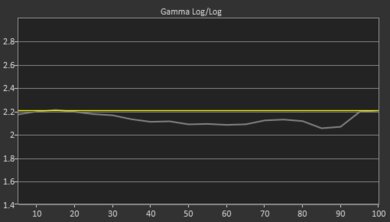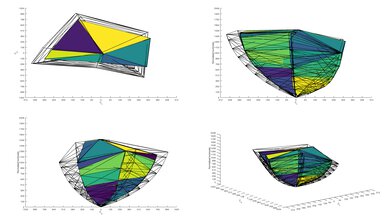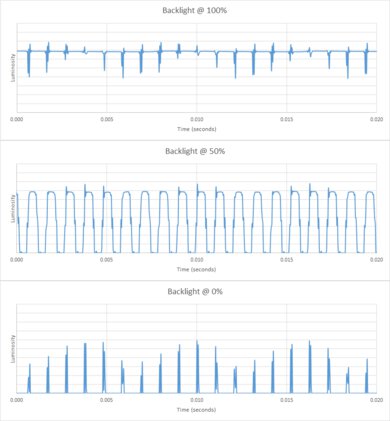The Samsung Q900TS 8k QLED is one of three 8k TVs in Samsung's 2020 lineup. While 8k is still something of a novelty with very little native content, this is still a great all-around TV that performs well in both dark and well-lit rooms. It has a decent contrast ratio, lower than typical for a VA panel, but a good local dimming feature helps it produce deeper blacks. The lower contrast is a result of Samsung's 'Ultra Viewing Angle' layer, which attempts to improve the viewing angles of VA panels. Unfortunately, that's not the case here, as the TV has disappointing viewing angles that make the image look washed out from the side. On the upside, it has an amazing response time and an optional Black Frame Insertion feature, making motion look smooth in fast-moving scenes. There's also FreeSync variable refresh rate (VRR) support, but it doesn't work fully. It includes an HDMI 2.1 port and can support a 4k @ 120Hz or 8k @ 60Hz signal, but neither of these works with 'Game' mode, which is unfortunate if you want to use this TV for next-gen consoles.
Our Verdict
The Samsung Q900TS is great for mixed usage. It's great for movies thanks to its good black uniformity and local dimming, which greatly improves its contrast ratio. It also performs well in sunny rooms since it gets bright enough to overcome glare. It also has no problem upscaling cable TV or Blu-ray movies. HDR content pops thanks to its wide color gamut and high peak brightness. Unfortunately, its viewing angles are disappointingly narrow, so it's not as well-suited to wide seating arrangements. That said, gamers should appreciate the fast response time, low input lag, and FreeSync support.
- Gets very bright.
- Excellent reflection handling.
- Fast response time.
- 'Ultra Viewing Angle' doesn't improve viewing angles.
- Contrast ratio is only decent.
The Samsung Q900TS is great for watching movies. It performs well in dark rooms thanks to its full-array local dimming and black uniformity, but its contrast ratio is lower than expected. It has no problem upscaling 1080p content like Blu-rays, although it doesn't display 4k content perfectly. There's a fair bit of stuttering as a result of its fast response time, but it can remove 24p judder from any source.
- Good local dimming.
- Can upscale Blu-rays without issue.
- Removes 24p judder from any source.
- Contrast ratio is only decent.
- Stuttering with low resolution content.
The Samsung Q900TS is great for watching TV shows during the day. It can get very bright and has excellent reflection handling, although the 'Ultra Viewing Angle' layer creates a rainbow-tinted effect when there are bright lights directly facing the screen, which some may find distracting. Despite the addition of the 'Ultra Viewing Angle' technology, the TV has disappointingly narrow viewing angles.
- Gets very bright.
- Excellent reflection handling.
- No issues upscaling lower resolution content like cable or DVD.
- Rainbow-like effect when bright lights shine directly on screen.
- 'Ultra Viewing Angle' doesn't improve viewing angles.
The Samsung Q900TS is great for watching sports. It has excellent reflection handling and high peak brightness, so it's well-suited to bright rooms. It also has an amazing response time, resulting in smooth motion, which is great for fast-moving sports. Unfortunately, it has narrow viewing angles, causing the image to look washed out from the side, so it's not well-suited to watching the game with a large group.
- Gets very bright.
- Excellent reflection handling.
- Fast response time.
- 'Ultra Viewing Angle' doesn't improve viewing angles.
- Noticeable 'dirty screen effect.'
The Samsung Q900TS is an excellent TV for playing video games. Its amazing response time makes motion look clear and it has an incredibly low input lag, so gaming feels responsive. Its contrast ratio is only decent, so it's not as well-suited to dark room gaming. It has native FreeSync support, but it's not compatible with G-SYNC and the VRR doesn't work with 1440p resolution. Unfortunately, 'Game' mode doesn't work with 4k @ 120Hz or 8k @ 60Hz.
- Fast response time.
- Supports FreeSync.
- Incredibly low input lag.
- VRR doesn't work in 1440p.
- Doesn't support 4k @ 120Hz or 8k @ 60Hz in 'Game' mode.
The Samsung Q900TS is very good for watching movies in HDR. It gets bright enough to make highlights in HDR content pop and it has a wide color gamut. However, its native contrast ratio is only decent, lower than a typical VA panel. Thankfully, it has good local dimming that greatly improves dark room performance. While it supports HDR10+, it doesn't support Dolby Vision.
- Good local dimming.
- Bright enough for HDR.
- Wide color gamut.
- Contrast ratio is only decent.
- Doesn't support Dolby Vision.
The Samsung Q900TS is excellent for HDR gaming. It has an incredibly low input lag in HDR, making for a responsive gaming experience. It also has a fast response time and supports FreeSync VRR, although the VRR doesn't work in 1440p. Also, 'Game' mode doesn't work in 4k @ 120Hz or 8k @ 60Hz. Still, games look as they should in HDR thanks to the TV's wide color gamut and high peak brightness, although the contrast ratio is lower than expected.
- Fast response time.
- Bright enough for HDR.
- Incredibly low input lag.
- VRR doesn't work in 1440p.
- Doesn't support 4k @ 120Hz or 8k @ 60Hz in 'Game' mode.
The Samsung Q900TS is an impressive TV for use as a PC monitor. It has an incredibly low input lag, creating a responsive desktop experience, and a fast response time. It also supports chroma 4:4:4. which is important for displaying text properly. Unfortunately, it has disappointing viewing angles, despite the 'Ultra Viewing Angle' layer, so the edges of the screen may look washed out when sitting up close.
- Excellent reflection handling.
- Displays proper chroma 4:4:4.
- Incredibly low input lag.
- 'Ultra Viewing Angle' doesn't improve viewing angles.
Changelog
- Updated Sep 26, 2025: We uploaded the latest brightness measurements and uniformity photos for the Accelerated Longevity Test.
- Updated Jul 08, 2025: We uploaded the latest brightness measurements and uniformity photos for the Accelerated Longevity Test.
- Updated Apr 17, 2025: We uploaded the latest brightness measurements and uniformity photos for the Accelerated Longevity Test.
- Updated Feb 11, 2025: We uploaded the latest brightness measurements and uniformity photos for the Accelerated Longevity Test.
Check Price
Differences Between Sizes And Variants
We tested the 65 inch Samsung Q900TS (QN65Q900TSFXZA), also sometimes referred to as the Q900T. For the most part, we expect our results to be valid for the 75 inch (QN75Q900TSFXZA) and 85 inch (QN85Q900TSFXZA) variants. This TV is nearly identical to the Samsung Q950TS, except the latter only comes in 85 inch size in the US and it comes with a One Connect box. In Germany, the model numbers for the 8k QLEDs start at Q700T and skip over Q900T, so the closest equivalent is the Q950TS.
| Size | US | Canada | UK | Italy | Germany |
|---|---|---|---|---|---|
| 65" | QN65Q900TSFXZA | QN65Q900TSFXZC | QE65Q900TSUXXU | QE65Q900TSTXZT | QE65Q950TSTXZG |
| 75" | QN75Q900TSFXZA | QN75Q900TSFXZC | QE75Q900TSUXXU | QE75Q900TSTXZT | QE75Q950TSTXZG |
| 85" | QN85Q900TSFXZA | QN85Q900TSFXZC | - | - | QE85Q950TSTXZG |
If someone comes across a different type of panel or their Samsung Q900TS doesn't correspond to our review, let us know, and we will update the review. Note that some tests, like gray uniformity, may vary between individual units.
Our unit was manufactured in August 2020. You can see the label here.
Popular TV Comparisons
The Samsung Q900TS is a great TV overall with high-end features like VRR support and an HDMI 2.1 port. While 8k TVs are still relatively new, it stands out among competitors because of its sleek 'infinity' screen design. That said, for its price, there are better 4k TVs out there. For more options, check out our recommendations for the best QLED TVs, the best 65 inch TVs, and the best TVs.
The Samsung Q900TS 8k QLED and the Samsung Q90/Q90T QLED are both high-end QLED TVs with a lot of great features and performance in the same ballpark. That said, the Q90T offers better value for the price. It has a higher native contrast ratio and much better viewing angles than the Q900TS. While both have fast response times and FreeSync VRR support, the Q90T is also compatible with G-SYNC. The biggest difference is that the Q90T is a 4k TV and the Q900TS is 8k, but since there's still very little 8k content, the value of 8k at this point is questionable.
The Samsung Q900TS 8k QLED is the successor to the Samsung Q900/Q900R 8k QLED, and they perform very similarly overall, although the Q900TS has a few notable improvements. The biggest difference is in design, as the Q900TS has 'infinity' bezels that make the screen look virtually borderless. It also supports eARC for enhanced audio passthrough and has a lower input lag. That said, the Q900R has much wider viewing angles, so it's better suited to wide seating arrangements.
The Samsung Q900TS 8k QLED and the Samsung Q800T 8k QLED perform quite similarly overall. The biggest difference is in design. The Q900TS has a virtually bezel-less design and the screen sits at a 3 degree backward tilt, but both are very sleek-looking TVs. Performance-wise, the Q900TS has a faster response time overall, and between the units we tested, it has much better color accuracy out-of-the-box. If you have a wide seating arrangement, the Q800T has better viewing angles.
The Samsung Q900TS 8k QLED and the LG CX OLED are very different TVs that use different panel technologies and have different resolutions. While the Samsung supports 8k, there's still very little 8k content, so the LG offers better picture quality at a lower price. The LG can produce perfect blacks and has a near-instantaneous response time. Although there is a risk of permanent burn-in with the LG, it shouldn't be a problem if you watch varied content.

We buy and test dozens of TVs yearly, taking an objective, data-driven approach to deliver results you can trust. Our testing process is complex, with hundreds of individual tests that take over a week to complete. Most of our tests are done with specially designed test patterns that mimic real content, but we also use the same sources you have at home to ensure our results match the real-world experience. We use two main tools for our testing: a Colorimetry Research CR-100 colorimeter and a CR-250 spectroradiometer.
Test Results

The Samsung Q900TS has a virtually borderless design with extremely thin bezels to make it look as if it's floating in the air. The stand is centered, and the TV is designed to sit at a slight backward angle. Overall, it's a very sleekly-designed TV that should look fantastic in any living room.
After nearly two years on the test, the uniformity issues on this TV are starting to get noticeably worse.
The brightness of this TV increased considerably between our initial measurements and the second-month measurements due to an automatic firmware update.
The back of the TV is textured plastic. There are tracks along the back and down the stand for cable management.
The Samsung Q900TS has a decent contrast ratio. Its native contrast is much lower than expected from a VA panel, as a result of the added 'Ultra Viewing Angle' layer meant to improve viewing angles at the expense of contrast. Thankfully, the local dimming feature improves the contrast immensely, so it can still produce deep blacks.
SDR brightness is excellent, although it varies quite a bit with content. It's exceptionally bright with small highlights and gets dimmer with larger areas. It should perform well in bright rooms.
We measured the peak brightness after calibration using the 'Movie' Picture Mode with the Color Tone set to 'Warm2', Brightness set to 'Max', and Local Dimming set to 'High'.
If you want the brightest image possible, we achieved 1323 cd/m² using the 'Dynamic' Picture Mode with default settings and Local Dimming set to 'High'.
Update 08/04/2021: Added the real content local dimming videos.
The Samsung Q900TS uses a full-array local dimming feature. The local dimming is good but has some issues. Most notably, there's quite a bit of black crush, as small details like stars are almost completely crushed and then gradually pop back in. That said, there's not too much blooming around bright objects and subtitles look okay for the most part. However, there's a noticeable ripple as the dimming zones turn on around subtitles. As with the Samsung Q800T QLED, transitions between zones are very visible, creating a 'golf ball effect' that's noticeable with the small circle spinning in our test pattern. That said, these issues are much less noticeable with real content.
We tested local dimming on High.
Update 08/04/2021: Added the real content local dimming videos.
HDR brightness is amazing. It gets bright enough for highlights in HDR content to pop. As with SDR, there's some variation in brightness across content.
We measured the HDR peak brightness before calibration using the 'Movie' Picture Mode with Local Dimming set to ‘High’, Brightness at ‘Max’, Contrast at ‘Max’, and Picture Clarity set to ‘Off’.
If you want the brightest image possible, use 'Dynamic' Picture Mode with default settings and Local Dimming set to 'High'. We were able to get 2740 cd/m² in the 10% window using these settings.
The Samsung Q900TS has good gray uniformity, but this can vary between units. The screen is noticeably darker around the corners, and there's some slight dirty screen effect, which may be noticeable during sports games with large bright areas taking up the screen. Uniformity is much better with darker images.
We experienced a bug while testing, where the backlight bled through noticeably if left on a static screen, most notably on a 5% gray slide but sometimes with actual content as well. You can see that here.
Note: We also experienced an issue with the backlight in the same area we noticed the backlight bleed, where a section of the backlight turned off and left black spots on the screen. This went away on its own, though, and we weren't able to recreate the issue after it happened the first time.
Additionally, note that the backlight on this TV is always visible, similar to the Samsung Q800T QLED, which causes uniformity issues that aren't reflected in our scoring. In particular, the dirty screen effect in real usage looks worse than it appears in our test photo. You can see a photo here that has been edited to replicate the effect as it appears in real life.
Black uniformity is good, although this can vary between units. There's some visible clouding throughout the screen with Local Dimming disabled. When enabled, the black uniformity is significantly improved, though there's still some noticeable blooming around bright objects.
The viewing angles are disappointing, especially considering it has the added 'Ultra Viewing Angle' layer. The color quickly begins to wash out as you move off-center, so it's not suggested for wide seating arrangements. We tested the viewing angle twice, once with Local Dimming set to 'Low' to test for color, and again with Local Dimming disabled to test for lightness, black level, and gamma.
The Samsung Q900TS has excellent reflection handling. The glossy coating does a good job of diffusing direct light reflections, although the 'Ultra Viewing Angle' layer causes intense lighting to scatter and create a rainbow-colored ripple effect.
Before calibration, the accuracy is impressive. There are very few noticeable inaccuracies with colors and shades of gray, but the gamma doesn't really follow the curve, so scenes appear brighter than they should. The color temperature is slightly warmer than the 6,500K target, but it's still very close. Note that out-of-the-box accuracy may vary between units.
After calibration, accuracy is fantastic. The color temperature is slightly warmer, so there may be a bit of red/yellow tint, but colors and shades of gray have improved. Gamma follows the target much more closely. Any remaining accuracies shouldn't be noticeable without a colorimeter.
You can see our recommended settings here.
The Samsung Q900TS uses a BGR subpixel layout, which can affect the way text is rendered when using the TV as a PC monitor. You can read more about it here. The pixels look blurry due to the extra 'Ultra Viewing Angle' layer.
The Samsung Q900TS has a great color gamut that's wide enough for HDR content. It has nearly full coverage of the DCI P3 color space used in most HDR content and decent coverage of the wider Rec. 2020 color space.
The EOTF is a bit higher than the target, causing scenes to appear brighter than they should, until it rolls off near the TV's max brightness. In 'Game' mode, the EOTF is slightly farther off the target and rolls off quicker. If you find HDR too dim, set Contrast Enhancer to 'High', ST.2084 to ‘Max’, and Shadow Details to 'Max', which results in a noticeably brighter image, as you can see in this EOTF.
The TV has good gradient handling. There's some banding in reds and greens and a little in grays as well, but it's not especially noticeable. Setting Noise Reduction to 'Auto' seems to help smooth out the gradients.
We don't expect VA panels to experience permanent image retention, as the VA panel in our long-term test appears immune.
The Samsung Q900TS has a Black Frame Insertion feature to help reduce motion blur. To reduce the flicker to 60Hz, set LED Clear Motion to 'On', and for 120Hz, set Picture Clarity to 'On'. In 'Game' mode, enabling LED Clear Motion with Game Motion Plus reduces the flicker from 120Hz to 60Hz. Note that the BFI score is based on what flicker it's capable of, and not how well it actually performs.
Due to the TV's fast response time, there's some noticeable stuttering with 24fps content, but less so with 60fps content.
The Samsung Q900TS can remove 24p judder from any source, as long as Picture Clarity is set to 'Custom' with sliders set to '0'.
The TV supports FreeSync variable refresh rate (VRR), although the screen flashes intermittently when using FreeSync. Unfortunately, it's not G-SYNC compatible, and 1440p doesn't work with VRR as it defaults to 4k instead of staying in 1440p.
The Samsung Q900TS has a remarkably low input lag. We tried to measure the input lag in 'Game' mode, but it appears that 'Game' mode doesn't work in 8k @ 60Hz or 4k @ 120Hz as the Input Signal Plus setting becomes grayed out. We tested the input lag for these using 'PC' mode and 'Blu-ray' mode, but the results for the 'Blu-ray' mode test in 4k @ 120Hz were unusable since it kept switching between two different input lag speeds. We also couldn't get usable data while testing the input lag at 4k with VRR enabled.
If you have this TV and can overcome these or other issues, let us know in the discussions.
The Samsung Q900TS supports all common resolutions. However, it doesn't support 4k @ 120Hz or 8k @ 60Hz in 'Game' mode, which may be an issue if you plan to use this TV for next-gen consoles. It can display proper chroma 4:4:4, which is important for text clarity. To enable this, set the input label to 'PC' and enable Input Signal Plus.
Update 05/19/2021: After a PS5 software update, Samsung TVs can now display 4k @ 120Hz in HDR.
The Samsung Q900TS supports any signal up to 4k @ 120Hz from either the PS5 or Xbox Series X. However, we don't test for 8k signals from the consoles.
If you want a similar TV with more HDMI 2.1 ports, consider the Samsung QN900A 8k QLED.
This TV supports eARC, allowing you to pass high-quality audio to a receiver over an HDMI connection. To use it, set eARC to 'Auto' and set Output to 'Passthrough'.
The frequency response is not bad. It can't produce a very rumbly bass, but the overall sound profile is fairly balanced, resulting in clear dialogue. It gets quite loud, so volume shouldn't be an issue in most environments. There's also a digital room correction feature.
The Samsung Q900TS has okay distortion performance. There's audible distortion at moderate listening levels, which gets much worse at max volume. However, distortion depends on the content, and some people may not hear it.
The TV runs on Samsung's Tizen OS, which is smooth and user-friendly for the most part.
We did experience a few bugs while testing the TV. For instance, we heard some coil whine and experienced random screen flickering, which you can see here.
The Samsung Q900TS comes with Samsung's OneRemote, which automatically detects and controls compatible connected devices. It also has a voice control button that can perform basic commands like changing channels or inputs, and it has quick access buttons for Netflix, Prime Video, and Samsung TV Plus. It comes in a premium-looking metal finish.






















































